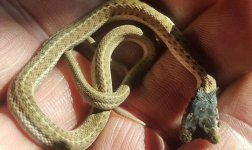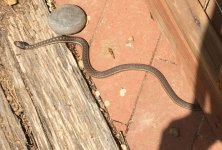| Range: |
 |
| Other Names: |
Garden Snake, Gardener Snake, Grass Snake |
| Description: |
Mostly gray, greenish gray or a gray brown. A dull yellowish to
whitish middorsal stripe down the back. Olive gray to olive brown
above, with alternating rows of black or brown spots. Belly light
gray, gray white with scattered black speckling or spotting, except on
throat. Specimens without middorsal stripe occur. Melanistic (black) specimens may
also occur. Scales are keeled. Adults are 18"- 42" in length. |
| Similar Species: |
Patchnoses and whipsnakes have smooth scales, a divided anal plate and no spots. The Common Garter has relatively larger eyes, generally 7 upper labial scales, a wide, yellow, vertebral stripe, often has red coloring between the lateral scales and usually a plain bluish gray belly. The Checkered Garter has neck blotches, more distinct squarish spots and the narrow lateral stripe is restricted to the 3rd scale row. The Black-necked Garter has well defined neck blotches and a yellow to orange vertebral stripe. The Plains Garter usually had 19 scale rows, seven upper labials and the lateral stripeon the 3rd and 4th scale rows. |
| Venom: |
Garters were long thought to be nonvenomous, but recent discoveries have revealed that they do in fact produce a mild neurotoxic venom. Garter snakes cannot kill humans with the small amounts of venom they produce, which is comparatively mild, and they also lack an effective means of delivering it. They do have enlarged teeth in the back of their mouth, but their gums are significantly larger. The Duvernoy's gland of garters are posterior (to the rear) of the snake's eyes. The mild venom is spread into wounds through a chewing action. - Wikipedia |
| Habitat: |
Frequents grassland, brush land, woodland, chaparral covered
hillsides, woodland and forests of pine and fir. Frequents permanent,
intermittent streams and springs. |
| Behavior: |
Maybe semi-aquatic. When handled, they will emit a foul smelling musk and occasionally bite |
| Hibernation: |
Hibernates in deep burrows or cracks in rock piles |
| Reproduction: |
Breeds in early spring and is live bearing to 4-27
young. Terrestrial. |
| Diet: |
Feeds on frogs, toads, tadpoles, fish, salamanders, lizards, small
mammals, earthworms, crustaceans and nestlings. There are records of them eating small snakes such as Lined Snakes |
Sources:



|























